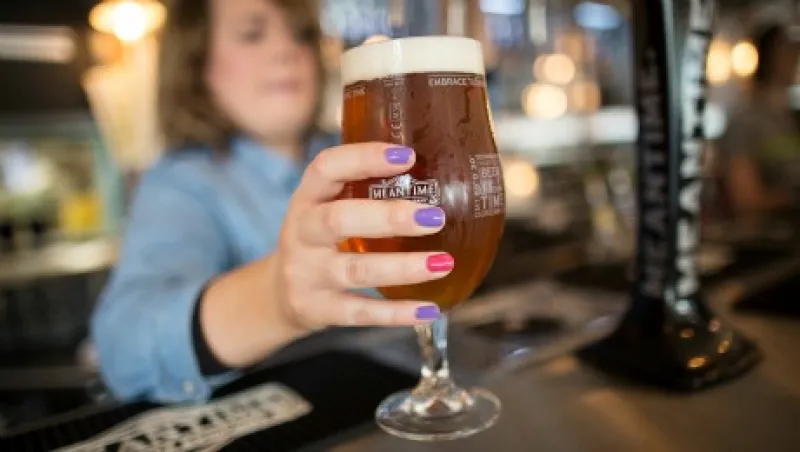Glasses will surely be clinked this Wednesday should Anheuser-Busch InBev, the world’s largest beer company, agree on a formal $104 billion offer to acquire SABMiller, its closest rival.
Should the two become one — forming a behemoth that analysts have taken to calling “Megabrew” — the executives behind the deal will have a staggering number of cold and foamy options from which to choose for their congratulatory toasts. A tie-up would unite brands such as AB InBev’s Budweiser, Stella Artois and Corona with SABMiller labels that include Grolsch, Peroni and South Africa’s Castle Lager, and produce a company controlling 30 percent of the world’s beer market by volume. The merger would be one of the largest in history in any industry.
If anyone wants to celebrate the merger with a truly “cool” beer, however, they’ll be out of luck. Cool belongs to craft beers — brands like Naked Pig, Polygamy Porter, Supplication and Son of a Peach. It’s India pale ales, stouts, sours and goses made in small batches and sold within 100 miles of your house, or imported from a gastropub-brewery in Montreal. This is where growth lives. From 2008 to 2014 the craft category saw its share of U.S. beer sales nearly triple, to 11 percent from 4 percent. And for the most part this space remains off-limits to global players.
“Craft’s volume is at about 11 percent in the U.S., where margins are highest,” says Caroline Levy, analyst at CLSA in New York. “Will it go to 20 percent? Absolutely. I’d say within seven years. It’s not ten years off.”
The craft beer renaissance began 30 years ago, but Millennials have made craft an obsession. They’re a group with “fragmented desires,” explains Levy. “They don’t all want the same thing, and they feel awful about doing everything the same way that everyone else has.” The shift is partly a function of the fragmented media market, she adds. “In 1953 almost 70 percent of households watched I Love Lucy, so if you were a brand advertising during that show, you were getting an incredible batting average,” she says. Today the most popular shows have a viewership in the low teens, “but at the same time, because of the Internet, it’s easy to launch a new brand.”
The upshot: 25 years ago there were fewer than 300 craft breweries in the country. Today there are an estimated 3,700.
The big brewers have employed a variety of tactics to restore some of their former barroom dominance. They have used their considerable advertising power to mock independent brands for being too highbrow and hipster-precious, while at the same time creating and marketing their own craftlike labels as highbrow and precious. They’ve begun investing in or buying smaller labels as well, like SABMiller’s recent purchase of the London craft label Meantime. “Anheuser-Busch InBev has bought craft brands in the U.S., Colombia and Brazil,” says Trevor Stirling, European beer analyst with Sanford C. Bernstein in London: “MillerCoors has bought in the U.S.A., and SABMiller bought a British craft brand. Expect more of the same.”
Craft breweries charge that big beer companies are also snapping up U.S. beer distributors at an alarming rate, thereby controlling shelf space.
Nevertheless, Stirling, like Levy, believes the craft beer industry has a strong outlook. In fact, he doesn’t believe the tie-up of two giants will have much impact on upstarts hawking their latest IPAs. “Obviously, there will be global consolidation, but on a market level there will be very little change,” he says. In fact, analysts expect AB InBev and SABMiller to sell off some brands, such as Miller in the U.S., to address antitrust concerns in certain markets.
To be sure, larger craft brands, which are sold nationwide and increasingly even shipped overseas, are beginning to see sales growth slowing. They’re becoming much like the Budweisers of the world: too big and too familiar. Boston–based Samuel Adams, for example, saw volume rise by only 6 percent in the first half of 2015, whereas U.S. craft beer production as a whole was up 16 percent. According to Stirling, it’s second-tier, regional brands that occupy the craft beer “it” segment, having more room for growth.
Levy also sees continued interest in hybrid concoctions, like Twisted Tea (owned by Sam Adams) and Mike’s Hard Lemonade. The hottest beer brand right now, she reports, is Not Your Father’s Root Beer, which has the taste and fizz of root beer with an alcohol by volume (ABV) of 5.9 percent. The hard cider trend also has staying power, she says, for the novelty factor and because it serves growing demand for gluten-free beverages. Finally, she feels that craft beer drinkers will continue to look for more buzz for their buck. According to London–based market research firm Mintel, 46 percent of new beers released between 2011 and 2014 were more than 6.5 percent ABV.
Looking ahead, analysts expect the larger global players to seek to increase revenue by pushing premium brands and by moving further into emerging markets. SABMiller’s strong franchise in Africa is a major reason AB InBev is pursuing the acquisition. Big beer may also do more with Mexican imports in the U.S., where Corona and Modelo Especial have enjoyed success, says Levy, in part because of advertising efforts and in part because they appeal to the growing Latino market segment.
As for the craft makers?
Stirling believes it’s not immediately clear what large independent brewers like Sam Adams can do to improve growth. But the microbreweries, he says, “should just keep doing what they’re doing.”
Get more on corporations .






